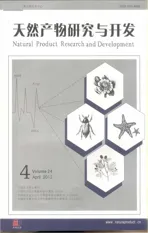四川溲疏的化学成分研究
2012-02-14李昌松余红伟陈晓珍吴晓青方冬梅李国友
李昌松,余红伟,陈晓珍,吴晓青,方冬梅,李国友*
1中国科学院成都生物研究所,成都610041;2中国科学院研究生院,北京100049; 3西南交通大学生命科学与工程学院,成都610031
Introduction
Deutzia setchuenensis Franch,a kind of ornamental and medicinal bush,belonging to the family Hydrangeaceae widely distributed in Jiangxi,Fujian,Hubei,Hunan,Guangdong,Guangxi,Guizhou,and Sichuan province[1].Previous studies reported the isolation of iridoid glucosides[2,3],saponins[4],and flavonoids[5]from this genus,but the chemical constituent of this plant have not been studied up to now.In the course of chemical investigation on this plant,we have obtained nine compounds from the 95% ethanol extract of the whole plants of D.setchuenensis.The structure of the compounds were identified as β-sitosterol(1),betulin (2),hydrangetin(3),oleanolic acid(4),cinnamic acid(5),oleanolic acid 3-O-β-D-glucuronopyranoside (6),β-daucosterol(7),oleanolic acid 3-O-(β-D-glucuronopyranoside-6-O-butyl ester)(8),and oleanolic acid 3-O-β-D-glucuronopyranosyl-28-3-O-β-D-glucopyranoside(9).Here,we describe the isolation and structure elucidation of these compounds.
Experimental
General
Melting point data:X-6 precise melting point apparatus (Beijing Fukai Science and Technology Development Company Limited);Optical rotations:Perkin-Elmer 341 polarimeter;FT-IR spectra:Perkin-Elmer spectrum one FT-IR spectrometer;NMR spectra:Bruker Advance 600 spectrometer(1H:600 MHz;13C:150 MHz),with TMS internal standard;ESI-MS spectra:Finnigan LCQDECAion trap mass spectrometer;HR-ESI-MS spectra Bruker BioTOF-Q mass spectrometer(Bruker Daltonics,Billerica,MA,USA).Silica gel(200-300 mesh,Qingdao Haiyang Chemical Co.Ltd.),RP-C18(40-63 μm,Merck KGaA,Darmstadt,Germany),MCI gel(CHP 20P,75-150 μm;Mitsubishi Chemical Industries,Tokyo,Japan).D101 macrosporous resin (Shanghai Moshu Scientific Instruments Co.Ltd.).
Plant material
The whole plants of Deutzia setchuenensis were collected in Yanbian County of Sichuan Province,China,in July 2008.A voucher specimen(A171-3)was authenticated by Prof.Hu Fa-ding at Chengdu Institute of Biology,Chinese Academy of Sciences(CAS),and deposited in the Herbarium of the Chengdu Institute of Biology,Chinese Academy of Sciences,CAS.
Extraction and Isolation
The air-dried,powdered whole plants of D.setchuenensis(4 kg)was exhaustively extracted with 95%EtOH (3 times,rt).The extract was concentrated in vacuum to yield a residue(300 g).The crude extract was suspended in H2O and then partitioned successively with petroleum ether,EtOAc,and n-BuOH to obtain petroleum ether(A,40 g),EtOAc(B,35 g),and n-BuOH (C,100g)fractions.Fraction B was subjected to silica gel column chromatography to yield B1 and B2.Fraction B1 was further chromatographied to give B11,B12,and B13(petroleum ether/acetone,10∶1,v/v) on a silica gel.Crystallization of B12(2 g)from acetone gave compound 1(1 g).Fraction B13 was chromatographied on a silica gel column eluted with CHCl3to give successively 2(30 mg)and 3(10 mg).Fraction B2(20 g)was further separated over silica gel column (CHCl3/MeOH,100∶1,v/v)to get B21,B22,and B23 based on TLC analysis.Fraction B21 was subjected to chromatography over MCI gel(MeOH/H2O,95∶5,v/v)and crystallize in CHCl3to give 4(50 mg).Fraction B22 was separated over silica gel column (CHCl3/MeOH,250∶1,v/v)to yield 5(400 mg),Fraction B23 was separated over RP-C18silica gel column(MeOH/H2O,2∶1,v/v)to give 6(100 mg). Fraction C was separated over macroporous resin D101 column(H2O/MeOH,100∶0,80∶20,60∶40,20∶80,0∶100,v/v)to get C1,C2 and C3.Compounds 7(15 mg)and 8(80 mg)were obtained from Fraction C3 by silica gel column(CHCl3/MeOH,15∶1,v/v).9(50 mg)was isolated from Fraction C2 by silica gel column eluted with n-BuOH saturated by water.
Identification
Compounds 1,4,and 7 were identified successively as β-sitosterol,oleanolic acid,and β-daucosterol by comparing them with authentic samples on TLC and comelting point.
Betulin(2) C30H50O2.white powder,mp.236-238℃.ESI-MS m/z:465[M+Na]+;1H NMR(CDCl3,600 MHz)δ:4.68(1H,s,H-29),4.58(1H,s,H-29),3.79(1H,d,J=10.5 Hz,H-28),3.33(1H,d,J=10.5 Hz,H-28),3.18(1H,m,H-3),1.68(3H,s,H-30),1.02(3H,s,H-26),0.98(3H,s,H-27),0.96(3H,s,H-23),0.82(3H,s,H-25),0.76(3H,s,H-24).13C NMR(CDCl3,150 MHz)δ:38.7(t,C-1),27.4(t,C-2),78.9(d,C-3),38.8(s,C-4),55.3(d,C-5),18.3(t,C-6),34.2(t,C-7),40.9 (s,C-8),50.4(d,C-9),37.2(s,C-10),20.8(t,C-11),25.2(t,C-12),37.3(d,C-13),42.7(s,C-14),27.1(t,C-15),29.2(t,C-16),47.8(s,C-17),48.8(d,C-18),47.8(d,C-19),150.5(s,C-20),29.8(t,C-21),33.9(t,C-22),27.9(s,C-23),15.3(s,sC-24),16.1(s,C-25),15.9(s,C-26)14.7(s,C-27),60.5(t,C-28),109.6(t,C-29),19.1(s,C-30).It was identified by comparison of the physical and spectral data with those reported[6].
Hydrangetin(3) C10H8O4.colorless flakes(CHCl3).mp 153-155℃.ESI-MS m/z:191[M-H]-.1H NMR (CDCl3,600 MHz)δ:7.63(1H,d,J=9.5 Hz,H-4),6.24(1H,d,J=9.5 Hz,H-3),7.11(1H,d,J= 8.5 Hz,H-5),6.90(1H,d,J=8.5 Hz,H-6),4.11 (3H,s,8-OCH3),6.47(1H,s,OH).13C NMR (CDCl3,150 MHz)δ:61.8(q,8-OCH3),112.2(d,C-6),112.6(d,C-3),113.2(s,C-4a),123.3(d,C-5),133.7(s,C-8),144.3(d,C-4),147.2(s,C-8a),152.1(s,C-7),160.4(s,C-2).The physical and spectral data are in accordance with those reported[7].
Cinnamic acid(5) C9H8O2.white powder,mp 131-133℃.ESI-MS m/z:187[M+K]+.1H NMR (CDCl3,600 MHz)δ:7.81(1H,d,J=16.0 Hz,H-2),7.57(2H,m,H-5,9),7.42(3H,m,H-6,H-7 and H-8),6.48(1H,d,J=16.0 Hz,H-3).13C NMR (CDCl3,150 MHz)δ:172.1(s,C-1),147.1(s,C-4),134.1(d,C-2),130.7(d,C-3),129.0(d,C-9),129.0(d,C-5),128.4(d,C-6),128.4(d,C-8),117.3(d,C-7).The physical and spectral data are identical to those reported[8].
Oleanolic acid 3-O-β-D-glucuronopyranoside(6)
C36H56O9.white powder.ESI-MS m/z:631[M -H]-.1H NMR(C5D5N,600 MHz)δ:5.45(1H,brs,H-12),4.91(1H,d,J=7.9 Hz,GlcA-H-1),4.52-4.03(4H,GlcA-H-2,GlcA-H-3,GlcA-H-4 and GlcAH-5),3.33(1H,dd,J=11.8,4.3 Hz,H-3),3.28 (1H,dd,J=13.6,3.9 Hz,H-18),1.32(3H,s),1.29(3H,s),1.01(3H,s),0.98(3H,s),0.97 (3H,s),0.96(6H,s),0.83(3H,s).13C NMR (C5D5N,150 MHz)δ:89.9(d,C-3),39.5(s,C-4),56.7(d,C-5),123.5(d,C-12),145.7(s,C-13),27.1(s,C-23),17.9(s,C-24),179.9(s,C-28),107.1(d,GlcA-C-1),76.3(d,GlcA-C-2),79.0(d,GlcA-C-3 and GlcA-C-5),72.8(d,GlcA-C-4),no signal(GlcA-C-6).The physical and spectral data are equal to those reported[9].
Oleanolic acid 3-O-(β-D-glucuronopyranoside-6-O-butyl ester)(8) C40H64O9.white powder.ESI-MS m/z:711[M+Na]+,727[M+K]+.1H NMR (C5D5N,600 MHz)δ:5.48(1H,brs,H-12),5.00 (1H,d,J=7.9 Hz,GlcA-H-1),4.62-4.10(4H,GlcA-H-2,GlcA-H-3,GlcA-H-4 and GlcA-H-5),3.7 (2H,brs,Butyl-H-1),3.37(1H,dd,J=11.8,4.3 Hz,H-3),3.30(1H,dd,J=13.6,3.9 Hz,H-18),1.32(3H,s),1.30(3H,s),1.01(3H,s),0.98 (3H,s),0.97(3H,s),0.96(6H,s),0.83(3H,s),0.78(3H,t,J=7.4 Hz,Butyl-H-4).13C NMR (C5D5N,150 MHz)δ:88.8(d,C-3),38.4(s,C-4),55.5(d,C-5),122.3(d,C-12),144.6(s,C-13),27.1(s,C-23),16.7(s,C-24),179.9(s,C-28),107.1(d,GlcA-C-1),75.2(d,GlcA-C-2),77.7(d, GlcA-C-3),72.8(d,GlcA-C-4),77.1(d,GlcA-C-5),170.1(s,GlcA-C-6),64.7(t,Butyl-C-1),30.63 (t,Butyl-C-2),19.00(t,Butyl-C-3),13.49(q,Butyl-C-4).The physical and spectral data are in consistent with those reported[9].
Oleanolicacid 3-O-β-D-glucuronopyranosyl-28-3-O-β-D-glucopyranoside(9) C42H66O14.white powder.ESI-MS m/z:817[M+Na]+,793[M-H]-.1H NMR(C5D5N,600 MHz)δ:6.3(1H,d,J=8.0 Hz,Glc-H-1),5.42(1H,brs,H-12),4.75(1H,d,J= 7.9 Hz,GlcA-H-1),4.45-3.91(10H,m,sugars),3.27(1H,dd,J=11.8,4.3 Hz,H-3),3.18(1H,dd,J=13.6,3.9 Hz,H-18),1.28(3H,s),1.28 (3H,s),1.26(3H,s),1.09(3H,s),0.95(3H,s),0.94(3H,s),0.90(3H,s),0.82(3H,s).13C NMR (C5D5N,150 MHz)δ:88.7(d,C-3),38.4(s,C-4),55.5(d,C-5),121.4(d,C-12),143.8(s,C-13),28.1(s,C-23),16.8(s,C-24),176.2(s,C-28),106.3(d,GlcA-C-1),75.0(d,GlcA-C-2),78.6(d,GlcA-C-3),73.4(d,GlcA-C-4),77.8(d,GlcA-C-5),95.5(d,Glc-C-1),73.9(d,Glc-C-2),78.6(d,Glc-C-3),70.9(d,Glc-C-4),79.1(d,Glc-C-5),62.0(d,Glc-C-6),no signal(GlcA-C-6).The physical and spectral data are in accordance with those reported[9].
Acid Hydrolysis of Compounds 6,8 and 9.
Each sample(5 mg)was refluxed with 10%HCl(4 mL)for 4 h.The reaction mixture was evaporated to dry and then partitioned with EtOAc and H2O.The EtOAc extract was purified by chromatography on Sephadex LH-20(2.5×100 cm,50 g).The aglycone of 6,8 and 9 was determined to be oleanolic acid by TLC comparison with authentic sample.The rest of the aqueous layer was neutralized(10%,N,N-dioctylmethylamine in CHCl3)and concentrated under reduced pressure.Glucose and glucuronic acid were identified by TLC comparison with authentic samples.
Alkaline Hydrolysis of Compounds 8 and 9.
The saponin(2 mg)in KOH 10%(2 mL)was heated at 100℃ in a sealed tube for 75 min.After acidification with HCl(pH 5),the monodesmosides were extacted with n-BuOH.The hydrolysates of compounds 8 and 9 were identified to be compound 6.The aqueous solution of compound 9 contained glucose,identified by TLC comparison with an authentic sample.
1 Institute of Botany,the Chinese Academy of Sciences.Genera Retrieval of China Higher Plants.Beijing:Science Press,1979.209.
2 Esposito P,Iavarone C,Sen A,et al.Scabrosidol,a newhighly oxygenated iridoid glucoside from Deutzia scabra.J Nat Prod,1983,46:614-618.
3 Esposito P,Iavarone C,Sen A,et al.Iridoid aglycones from Deutzia scabra.Phytochem,1984,23:803-807.
4 Malaviya N,Pal R,Khanna NM.Saponins from Deutzia corybosa.Phytochem,1991,30:2789-2800.
5 Dembinska-Migas W,Gill S,Wojciechowska F.Flavonoid compounds in Deutzia scabra Thunb.Herba Pol,1986,32: 75-80.
6 Winston FT,Lynn CB,Azzam A.Lupane triterpenoids of Salacia cordata.J Nat Prod,1992,55:395-398.
7 Liu Q,Liu ZL,Tian X.Study on steroids of Cacalia tangutica.Chin J Chin Mat Med,2008,33:1035-1038.
8 Zhang J,He XW,Gao JC,et al.Study on chemical comstituents from Alpinia tonkinensis.Chin Pharm J,2003,38:502-503.
9 Hu M,Ogawa K,Sashida Y,et al.Triterpenoid glucuronide saponins from root bark of Aralia armata.Phytochem,1995,39:179-184.
